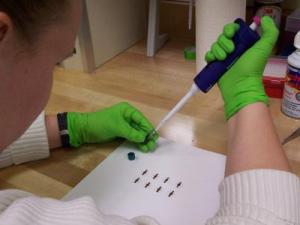Researchers from the National Institute of Standards and Technology (NIST) and the Food and Drug Administration (FDA) have demonstrated that they can make sensitive chemical analyses of minute samples of nanoparticles by, essentially, roasting them on top of a quartz crystal.
The NIST-developed technique, "microscale thermogravimetric analysis," holds promise for studying nanomaterials in biology and the environment, where sample sizes often are quite small and larger-scale analysis won't work.
 Small piezoelectric quartz crystals are the key to micro thermogavimetric analysis. Here, minute amounts of the test sample are deposited on the crystals. Credit: Kar/National Institute of Standards and Technology
Small piezoelectric quartz crystals are the key to micro thermogavimetric analysis. Here, minute amounts of the test sample are deposited on the crystals. Credit: Kar/National Institute of Standards and Technology
Chemical analysis of nanoparticles is a challenging task, and not just because they're small. They're also complicated. They can become coated with other materials in their environment, and the question becomes, what materials? Or they might have been engineered with a coating, perhaps to provide anchor points for drug molecules, and then the question can be, how complete is the coating? In nanoelectronics, the question may be, how pure is the sample and just what are the impurities?
Researchers have an alphabetic array of tools for this, including scanning, transmission or atomic force microscopy (SEM/TEM/AFM); dynamic light scattering (DLS); nuclear magnetic resonance (NMR); and sundry spectrometry techniques, but they all have a variety of limitations, including complex sample preparation or the difficulty of analyzing enough particles to get a statistically significant result.
On the other hand, one technique, thermogravimetric analysis (TGA) is quite straight-forward. The sample is heated and monitored for changes in mass as the temperature increases. Sudden changes in mass correlate with the energies needed to decompose, oxidize, dehydrate or otherwise chemically change components in the sample. If you have some idea of what you start with, TGA can tell you much more, but it requires pretty substantial sample sizes.
NIST's technique is essentially the same except that a small piezoelectric quartz crystal is substituted for the mass scale. A tiny amount of a nanomaterial sample deposited on the crystal dampens the crystal's resonant frequency, and as the sample grows lighter, the frequency shifts. NIST researchers originally applied it to measure the purity of carbon nanotube samples.
In this latest paper, the research team tested the utility of microTGA on typical nanomaterial analysis problems, including assessing the purity of carbon nanotubes, determining the amount of surface-bound ligands (i.e., molecular anchors) on gold nanoparticles, and testing for the presence of PEG, a polymer commonly used in medicine on silicon oxide nanoparticles.
"Our results are a pretty close match to other techniques," reports NIST analytical chemist Elisabeth Mansfield, "but using far less of a sample."
In fact, the team reports, microTGA gets results using samples a thousand times smaller than conventional techniques. It can work with one microgram of sample and detect mass changes of less than a nanogram. "That's important because you often don't have much of a sample.," Mansfield says," If you're pulling nanoparticles out of a water sample from the environment to measure how much exists in a real world sample, you're going to have very little to work with."
"In nanomedicine, the surface chemistry is oftentimes critically important to the performance of the nanomaterial," notes FDA chemist Katherine Tyner. "When working with real life samples, we may only have a very small sample amount. MicroTGA allows us to obtain information that we otherwise would not be able to get with conventional techniques."